Climbing the 14 Eight-thousanders: Facts & Information
There are 14 independent mountains that reach an elevation of 8,000 metres (26,200 feet) or more on Earth, all of which are situated in the heart of Asia.
The vast majority of the world’s eight thousanders are located in the Himalayas, in both Nepal and Tibet (China), with three others located in the Karakoram Range of Pakistan.
Even before the French climbers Maurice Herzog and Louis Lachenal reached the summit of Annapurna I in 1950, these imposing mountains have inspired outdoor adventurers and become coveted targets of experienced mountaineers.
Keep reading: Five Trekking and Climbing Destinations In the Nepalese Himalayas
However, climbing up to 8,000 metres in elevation comes with plenty of challenges and adversity. While some 8000ers are less challenging than others, none are easy to summit.
For this reason, only about 40 people have ever managed to climb all 14 of them, with Reinhold Messner being the first to complete the feat in 1986.
The Fourteen 8000ers at a Glance
| Peak | Elevation | Country |
|---|---|---|
| Everest | 8,849 m (29,032 ft) | Nepal & China |
| K2 | 8,611 m (28,251 ft) | Pakistan & China |
| Kangchenjunga | 8,586 m (28,169 ft) | Nepal & India |
| Lhotse | 8,516 m (27,940 ft) | Nepal & China |
| Makalu | 8,485 m (27,838 ft) | Nepal & China |
| Cho Oyu | 8,188 m (26,864 ft) | Nepal & China |
| Dhaulagiri I | 8,167 m (26,795 ft) | Nepal |
| Manaslu | 8,163 m (26,781 ft) | Nepal |
| Nanga Parbat | 8,125 m (26,657 ft) | Pakistan |
| Annapurna I | 8,091 m (26,545 ft) | Nepal |
| Gasherbrum I | 8,080 m (26,510 ft) | Pakistan & China |
| Broad Peak | 8,051 m (26,414 ft) | Pakistan & China |
| Gasherbum II | 8,034 m (26,358 ft) | Pakistan & China |
| Shishapangma | 8,027 m (26,335 ft) | China |
Challenges of climbing any 8000er
The two main challenges for climbers at such high elevations are the lack of oxygen and climatic conditions. At 8,000 metres, there is roughly a third less oxygen in the air than there is at sea level. This means that basic decision making and physical exertion become very difficult.
The weather is the other main challenge. While it is always below freezing at such high elevations, climbers are also often left exposed to the elements. Even during the dry season, storms can form and envelope these peaks quickly, leaving climbers with limited options to seek shelter.
How to prepare to climb an 8000er
Due to all of the challenges associated with climbing an 8000er, making the necessary preparations is paramount to a successful ascent.
Chief among these is being in peak physical condition. Climbing at high altitude requires an incredible high level of stamina and strength, as lower levels of oxygen in the air make every single motion more physically taxing.
Most guides recommend spending at least six to nine months improving cardiovascular endurance, leg, chest, back and upper body strength as well as flexibility prior to heading to central Asia to take on one of these climbs.
For climbers with little previous experience, jumping straight into climbing an 8000er is not safe or smart. It is best to start slow and try climbing an easier peak in order to learn all the necessary skills and techniques, Mountains such as Mount Baker, in Washington state, Gran Paradiso, in northwestern Italy, and Lanín Volcano, on the Argentine-Chilean border, are all deemed to be the perfect places for first-time mountaineering trips.
As climbers gain confidence on starter peaks, they will be able to matriculate to intermediate ones and spend more time at higher altitudes. Once a climber can confidently summit the likes of Mont Blanc on the French-Italian border or Mount Rainier, also in Washington state, trying out an ascent of one of the easier 8000ers comes into reach.
Even if it is not on a technically difficult climb, most guides recommend previous high altitude experience prior to arriving in the Himalayas or Karakoram Range. This way, the body can adjust to functioning with lower levels of oxygen and is prepared to enter the death zone, at 8,000 metres.
Get out and get going!
In spite (or because) of these dangers and adversities, hundreds of climbers head to the slopes of the world’s 8000ers each season. Below we’ve listed some facts and information about each to help prepare you for your next eight thousander expedition.
1. Everest

Situated in the Mahālangūr Himāl subrange of the Himalayas and towering over the border between Nepal and Tibet (China), Mount Everest is the tallest mountain in the world and, as a result, the most frequently climbed 8000er.
The first successful ascent of Everest came on 29 May 1953 when Edmund Hillary and Tenzing Norgay made it to the summit using the South Col route, which remains the most popular to date.
Prior to this ascent, there had been a number of other attempts to climb Everest, beginning in the early 1900s. The northern route, which is the other main route to the top, was the first route used in an attempt to summit the peak.
How to get there
For climbers headed to Everest Base Camp, on the southern slopes of the mountain, most trips will begin with a flight into Tribhuvan International Airport (KTM), in Kathmandu.
Keep reading: Everest Base Camp Guide: What to Know Before You Go
From here, climbers will meet the guide and transfer to Lukla, before making the two-week trek through Sagarmatha National Park and on to base camp.
Climbers headed to the northeast route will either fly into Kathmandu and transfer by vehicle to the Tibetan border and on to the northern base camp (which can be reached by vehicle) or fly into Lhasa Gonggar Airport (LXA) and transfer to the northern base camp.
Challenges and difficulty
Due to its immense elevation, Mount Everest is one of the toughest mountains on Earth to climb. The combination of time spent in the death zone and the incredibly cold temperatures – which hover around –40 ºC (–40 ºF) at the summit – are the main challenges climbers will face en route to the summit.
However, Mount Everest is not an overly technical mountain, with climbers only needing to have intermediate-level snow and ice climbing abilities and previous experience with ladder and fixed-rope climbing.
As a result, proper acclimatisation and physical fitness are more important than a very high level of technical ability for the climb.
Routes to the summit
Contemporarily, Everest is most often climbed via the South Col route on the Nepalese side of the border. The route is not very technical, with intermediate-level snow and ice climbing as well as ladder and fixed-rope climbing required to reach the summit.
The northeast ridge route, which starts from the Tibetan side of Everest, is more technically challenging, but also slightly faster since base camp can be reached by jeep. Due to visa restrictions (one visa for China and a separate one for Tibet), however, the route is much less popular.
Quick facts:
- Elevation: 8,848 m (29,029 ft)
- Location: Nepal, Tibet (China)
- Duration: 2 months
- Climbing season: April to May
2. K2
.jpg)
The world’s second highest mountain sits 1,300 kilometres (800 miles) northwest of Everest and towers above the Pakistani-Tibetan (Chinese) border.
Located in the heart of the Karakoram Range, K2 is widely considered to be one of the toughest 8000ers to summit. A combination of high elevations, technically difficult climbing and volatile weather conditions each present different types of challenges to expeditions.
Keep reading: Summary of K2 Winter 2021 thus far
The first ascent of the distinctive pyramid-shaped peak came on 31 July 1954 when two Italian climbers made it to the summit via what is now the normal route. The successful ascent came after more than 50 years of failed attempts to climb the peak.
How to get there
Most climbers headed to K2 begin their trip with a flight into Islamabad International Airport (ISB). From here, most guides will meet with participants and transfer to Skardu. From Skardu, it takes about 10 days of driving and trekking to get to base camp.
Challenges and difficulty
Of all the 8000ers, K2 provides the most rigorous technical challenge. Advanced levels of mixed rock, ice and snow climbing are all required throughout the ascent to the summit.
On top of the technical difficulty, the vast majority of the most technical parts are at high elevations and on exposed ridgelines, leaving climbers exposed to the elements with no palace to seek shelter.
Due to the location of K2 on the Karakoram Range, the peak is prone to receiving day-long storms that arrive with little warning. Poor infrastructure around the mountain means accurate forecasts are difficult to make and at higher elevations, conditions change rapidly. As a result, it is best to add plenty of extra days to the trip in order to accommodate patches of bad weather.
Routes to the summit
The route taken by Lino Lacedelli and Achille Compagnoni on their way to the top was dubbed the Abruzzi spur and remains the most commonly taken route. Beginning from 5,400 metres (17,700 feet), climbers will follow a series of rock ribs before making two technical rock climbs and following a ridge line to the couloir that leads to the summit.
The other most commonly taken route is the South-southeast spur, which has a slightly more remote starting point, but is considered a bit easier than the Abruzzi spur.
Quick facts:
- Elevation: 8,614 m (28,261 ft)
- Location: Pakistan, Tibet (China)
- Duration: 2 months
- Climbing season: June to September
3. Kangchenjunga

Also known as Kanchenjunga, the highest peak in India and third highest on Earth towers over the country’s border with Nepal and holds the distinction of being the easternmost 8000er.
The first ascent of the peak came on 25 May 1955, when a British expedition led by Joe Brown and George Band made it to the top. The expedition stopped short of the true summit as a result of a promise made by Brown and Band to the local ruler to keep the summit intact. Most guided trips since have generally followed suit.
How to get there
Climbers heading to Kangchenjunga will generally start with a flight into Tribhuvan International Airport (KTM), in Kathmandu. From here, climbers will meet the guide and usually transfer to Suketar Airport, in the east of the country.
After arriving at the airport, climbers will need to make the 10 to 14-day trek to one of the base camps generally used to ascend the mountain.
Challenges and difficulty
Due to its remote location, Kangchenjunga is not only a challenging peak to climb, but it is also tough to approach. Little infrastructure nearby means the trails are rough underfoot. Once the base of the peak has been reached, the ascent toward the summit requires a high level of glacier, snow and ice climbing.
As with all of the other 8000ers, elevation is also an issue for climbers and plenty of time needs to be spent acclimatising on the slopes of the peak prior to a successful summit ascent.
Routes to the summit
There are three main routes – the southwestern, northwestern, and northeastern – that lead to Kangchenjunga's summit, all of which begin from the Nepalese side. None of the routes is considered easier than the others, so which one is climbed generally depends on the guide service.
Climbing the one trail that leads up from the Indian side has been banned by the Indian government since 2000.
Quick facts:
- Elevation: 8,586 m (28,169 ft)
- Location: Nepal, India
- Duration: 40 to 60 days
- Climbing season: April to May, September to October
4. Lhotse
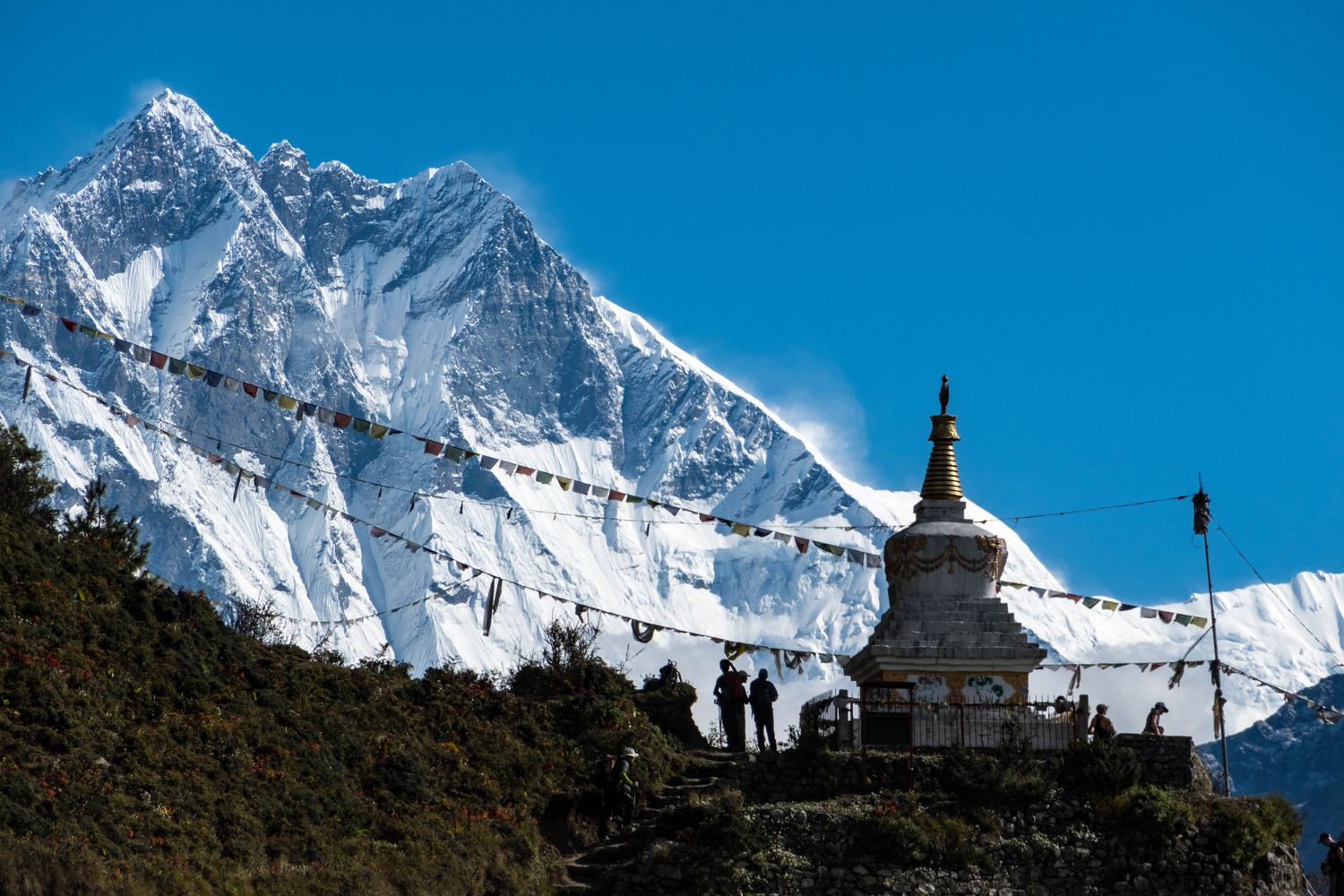
Situated in the shadow of Mount Everest, Lhotse is the fourth tallest mountain on Earth and a challenging mountaineering destination.
The peak is connected to the Everest massif by the southern col and is composed of one main summit and two minor summits – Lhotse Middle (8,414 metres/27,605 feet) and Lhotse Shar (8,383 metres/27,503 feet).
Due to its close proximity to Everest, Lhotse is often mistaken for the southern summit of the massif and as a result few serious attempts were made to climb the peak. The first ascent finally came on 18 May 1956 when two Swiss climbers – Ernst Reiss and Fritz Luchsinge – arrived at the summit.
How to get there
The Everest Base Camp is also the starting point for climbing Lhotse. However, most guides opt to meet at Tribhuvan International Airport (KTM), in Kathmandu.
From here, most provide transport to Lukla and accompany the climber on the two-week trek through Sagarmatha National Park and on to the base camp.
Challenges and difficulty
Compared to the rest of the world’s 8000ers, Lhotse is an intermediate-level challenge for adequately prepared mountaineers.
Technically speaking climbers will employ a fairly high level of glacier travel, snow climbing and ice climbing.
While the peak is not very prominent (only 610 metres/2,000 feet), all the climbing takes place at extremely high altitude. As a result, it is important to spend plenty of time acclimatising before making the final summit push.
Routes to the summit
There is one main route used to climb Lhotse – the South Face route –- which is technically challenging and requires a high level of glacier, snow and ice climbing. The ascent begins from Everest Base Camp and follows the South Col route all the way until the Yellow Band.
From here, climbers will take a right and proceed to the south face of Lhotse. After a technical ice climbing ascent of the south face, one of the most impressive walls in the Himalayas, participants climb through a narrow couloir and continue on to the summit.
Quick facts:
- Elevation: 8,516 m (27,940 ft)
- Location: Nepal, Tibet (China)
- Duration: 4 to 6 weeks
- Climbing season: April to May, September to October
5. Makalu

Situated just 20 kilometres (12 miles) southeast of Everest, Makalu is the fifth highest mountain on Earth and stands out for its near-perfect pyramidal shape, with four well-defined ridge lines leading up to the summit.
The peak was first successfully climbed on 15 May 1955 by a team of French mountaineers led by Lionel Terray and Jean Couzy, who climbed up via the north face and northwest ridge, which remains the most commonly used route to date.
How to get there
Any trip to Makalu will begin with a flight into Tribhuvan International Airport (KTM), in Kathmandu. Most guides will opt to meet you here and arrange for transportation to Tumlingtar. From Tumlingtar, it takes about one week to trek to the Makalu base camp.
Challenges and difficulty
Makalu is widely considered to be one of the most technically challenging and difficult of the 8000ers to climb.
Along with a high level of physical fitness and proper acclimatisation, the peak requires advanced snow, rock and ice climbing abilities over the extremely exposed ridgelines all the way up to the summit.
Routes to the summit
The most frequently taken route combines climbing the north face and then the northeast ridge via the saddle between Makalu and Kangchungtse. While it is the easiest route, it still requires plenty of technical climbing over all sorts of terrains.
Other routes include the South East Ridge, South Face, South West Face, West Pillar Route, West Ridge and West Face.
Quick facts:
- Elevation: 8,485 m (27,838 ft)
- Location: Nepal, Tibet (China)
- Duration: 6 to 8 weeks
- Climbing season: April to May, September to October
6. Cho Oyu
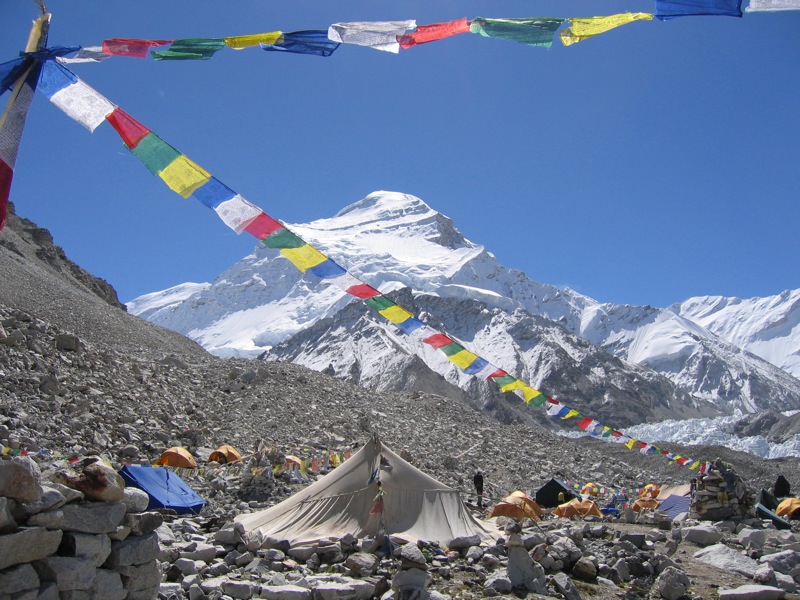
Straddling the border between China (Tibet) and Nepal, roughly 20 kilometres (12 miles) west of Everest, Cho Oyu is the sixth tallest mountain in the world and widely considered to be the easiest of the 8000ers to climb.
The first successful ascent of the peak came on 19 October 1954 when an Austrian expedition led by Herbert Tichy, Joseph Jöchler and Sherpa Pasang Dawa Lama summited the mountain via the northwest ridge.
How to get there
There are two main ways to get to Cho Oyu. The most common is to fly into Tribhuvan International Airport (KTM) and transfer by vehicle into Tibet (China) and then drive on to the base camp. The other option is to fly into Lhasa Gonggar Airport (LXA) and spend a long day driving to the base camp from the Tibetan capital.
Challenges and difficulty
The Nepalese Mountaineering Association has classified Cho Oyu as a trekking peak – meaning very little technical climbing is needed to get to the top – however, some previous snow and glacier climbing experience is helpful and there are two technical sections en route to the summit.
While Cho Oyu is considered one of the easiest of the 8000ers to climb, most guides recommend participants ot have previous experience at 7,000 metres (23,000 feet) or more prior to booking the trip.
Routes to the summit
Since the first ascent was made more than half of a century ago, the normal route to climb Cho Oyu has become the west ridge/west face route. A combination of some modest snow, ice and glacier climbing is needed to reach the top.
Away from the normal route, it is also possible to climb via the north face of the mountain, but this follows a far more technically difficult and exposed route to the summit.
There are also a few routes from the southern side of the mountain, in Nepal, but these require a week-long approach on foot to the base of the peak and are also more technically challenging than the normal route.
Quick facts:
- Elevation: 8,188 m (26,864 ft)
- Location: Nepal, Tibet (China)
- Duration: 50 days
- Climbing season: May to June, September to October
7. Dhaulagiri I
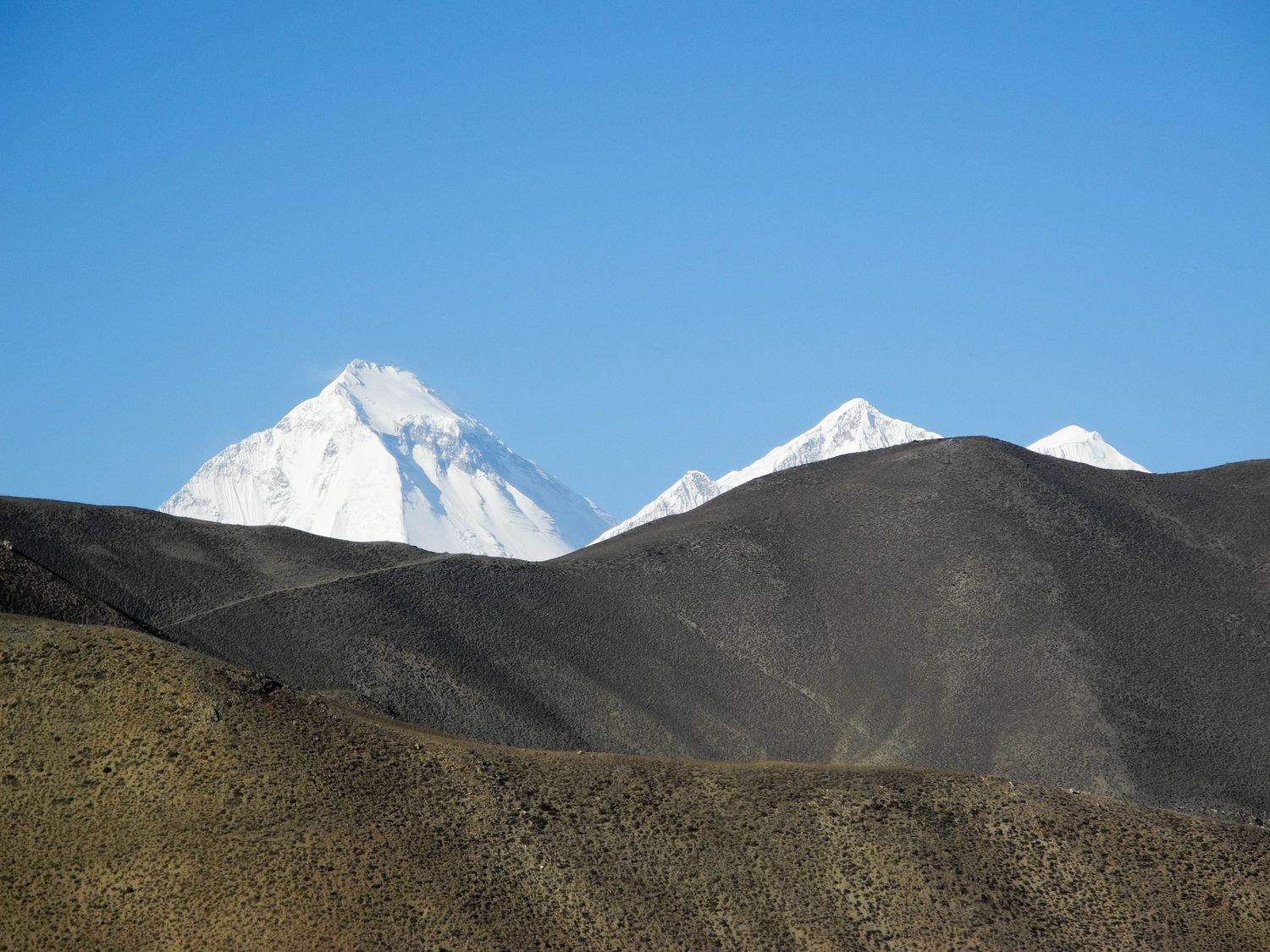
Towering over the stunning landscapes of central Nepal, Dhaulagiri I is the seventh tallest mountain in the world and the highest peak to be solely located within one country.
Situated just to the west of the Annapurna conservation area, Dhaulagiri I was first climbed on 13 May 1960, by a Swiss-Austran expedition led by Max Eiselin via the northeast ridge.
How to get there
Any trip to Dhaulagiri will begin with a flight into Tribhuvan International Airport (KTM), in Kathmandu. Most guides will opt to meet here and arrange transport to Pokhara. From Pokhara, it will take about 10 days to trek to the mountain’s base camp.
Challenges and difficulty
Dhaulagiri I is frequently considered to be one of the most accessible 8000ers, which makes it a popular destination for climbers training for Everest. However, the peak is quite technically challenging and requires advanced rock, snow and ice climbing.
Along with the technical difficulties, the ascent is quite steep and the route is prone to avalanches, so proper safety and rescue techniques are paramount, as is a high level of physical fitness.
Routes to the summit
The main route up to the summit of the massif is the same northeast route Eiselin used. The ascent includes a multi-pitch ascent of a distinctive rock formation, known as the Eiger, followed by a traverse of a series of seracs below the summit ridge and final ascent along the northeast ridgeline.
Quick facts:
- Elevation: 8,167 metres (26,795 feet)
- Location: Nepal
- Duration: 4 to 6 weeks
- Climbing season: April to May, September to October
8. Manaslu
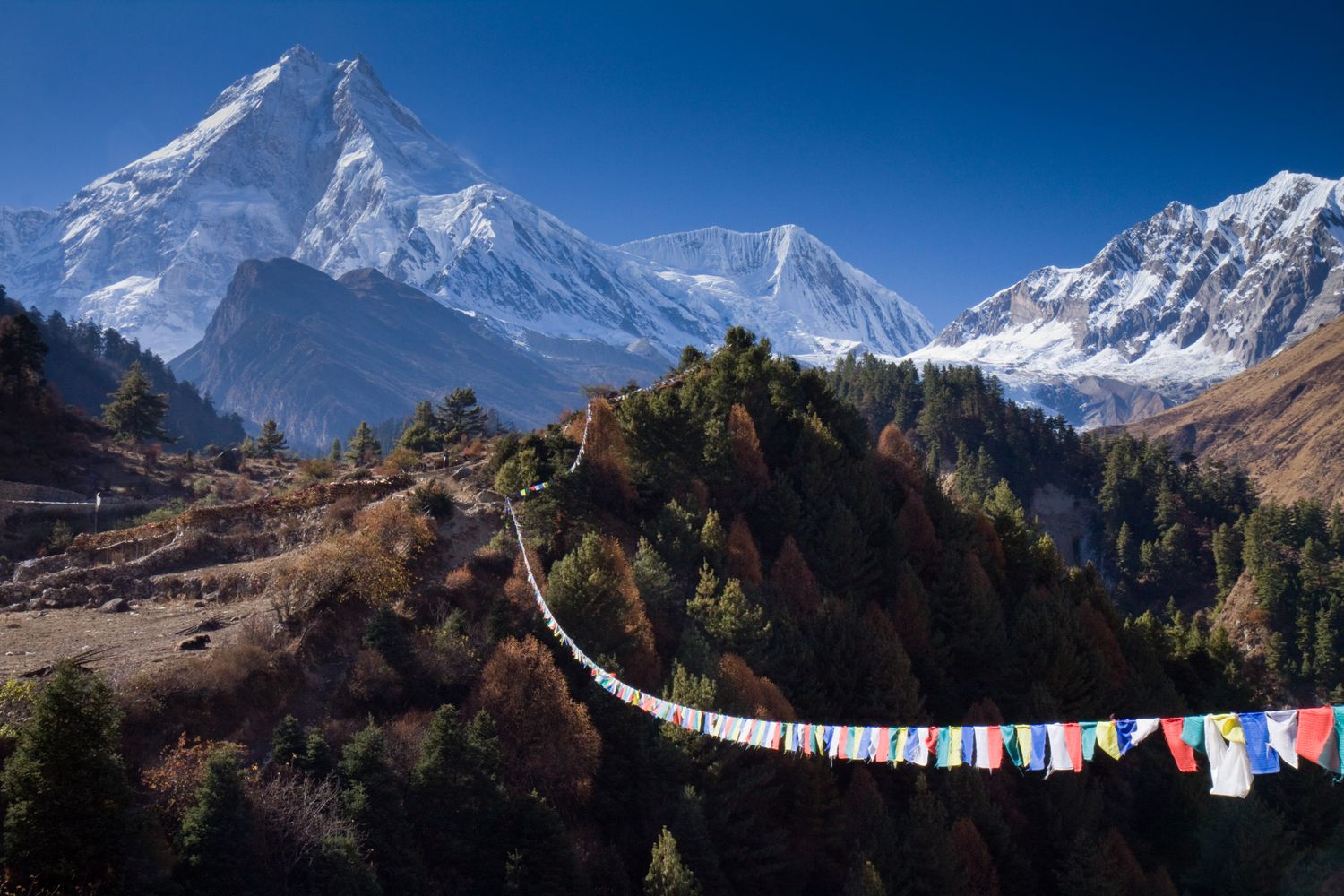
Situated in west-central Nepal and rising high above the rest of the Ghurka massif, Manaslu is the eighth highest mountain in the world and a popular mountaineering destination.
The peak was first climbed on 9 May 1956 by a Japanese expedition led by Toshio Imanishi and his Sherpa guide, Gyaltsen Norbu.
How to get there
Any trip to Manaslu will begin with a flight into Tribhuvan International Airport (KTM), in Kathmandu. Most guides will opt to meet you here and arrange for transportation to Besishar. From the small settlement, climbers will spend one week trekking to the base camp before acclimatising.
Challenges and difficulty
Due to the long and sloping ridgelines that lead up to the summit from each side of the peak, Manaslu is considered to be one of the easier 8000ers to climb.
Due to the length and low grade of the climb, most of the peak can simply be hiked. However, toward the summit, an intermediate level of snow and ice climbing abilities are required to complete the ascent.
Routes to the summit
Part of what makes Manaslu unique among 8000ers is the number of routes up to the summit. There are six well-established routes used to reach the top.
The easiest of these is the northeast face, which requires a long hiking approach from the high camp before some technical climbing is employed right below the summit
The toughest is the south face, which also requires a fairly high level of technical rock climbing, snow and ice climbing abilities up the steepest section of the peak.
Quick facts:
- Elevation: 8,163 m (26,781 ft)
- Location: Nepal
- Duration: 4 to 6 weeks
- Climbing season: April to May, September to October
9. Nanga Parbat
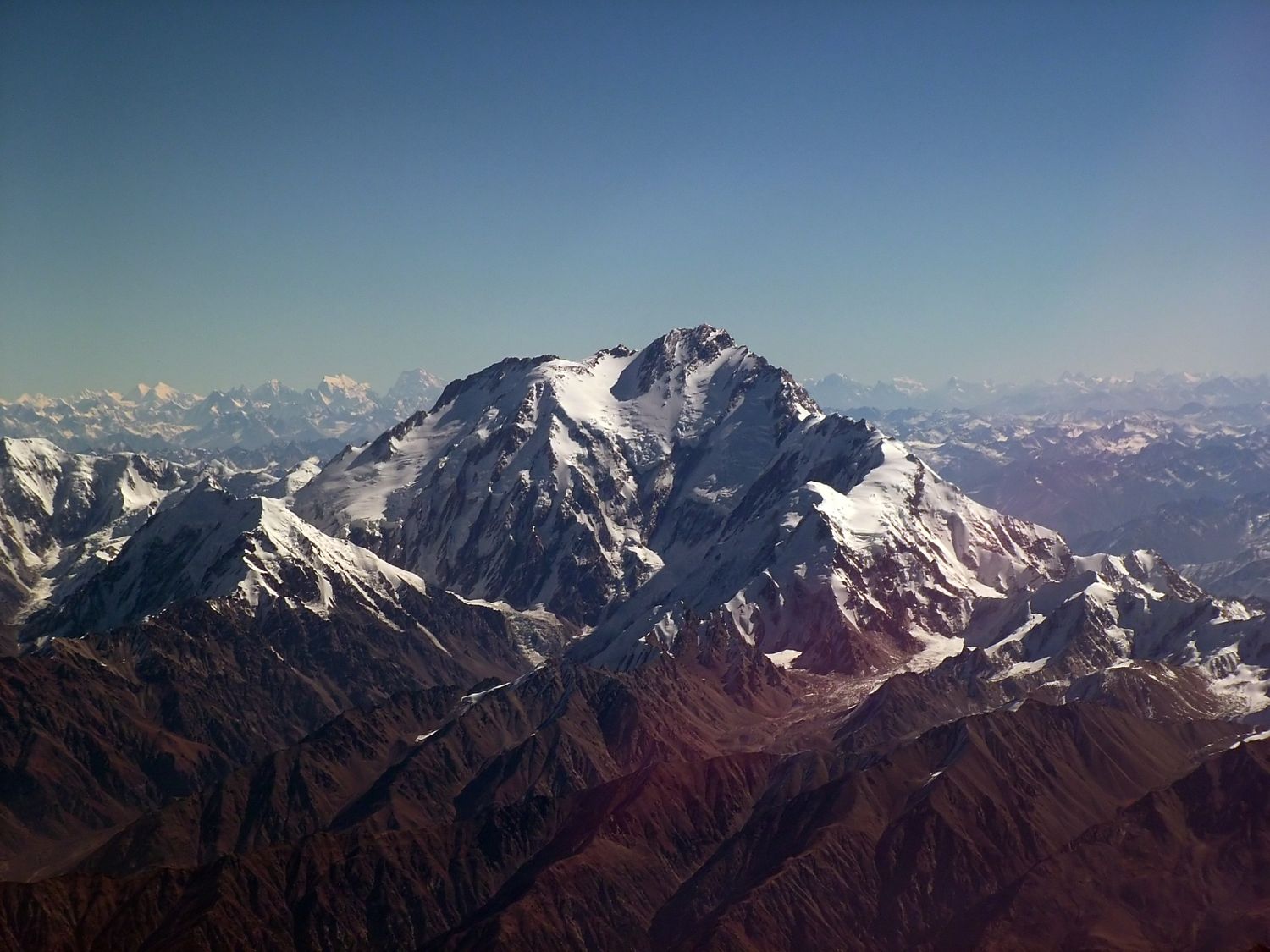
Located in the remote northern Pakistani region of Gilgit-Baltistan, Nanga Parbat rises high above the Fairy Meadows and cuts a distinctive figure above the horizon.
The world’s ninth highest mountain was first climbed on 3 July 1953 by Austrian mountaineer Hermann Buhl, who successfully traversed the eastern ridge on his own and without supplemental oxygen.
How to get there
The vast majority of trips to Nanga Parbat begin with a flight into Islamabad International Airport (ISB). Most guides will opt to meet here and provide transport to Chilas. From here, it takes three to four days of driving and trekking to reach the peak’s base camp.
Challenges and difficulty
Buhl’s ascent is still considered a remarkable feat as Nanga Parbat is widely considered to be an advanced mountaineering challenge. Even the easiest route to the summit requires a high level of rock, ice and snow climbing.
However, the challenges of climbing Nanga Parbat begin even before this. Due to its remote location, arriving at the base camp requires a challenging trek and plenty of coordination to bring all of the necessary food and gear.
The weather in this remote part of the Karakoram Range also presents plenty of challenges, with storms forming quickly and sweeping onto the mountain. As a result, it is important to have plenty of extra days available in case inclement weather delays the ascent.
Routes to the summit
The main route up Nagna Parbat is the Kinshofer Route on the western Diamir Face. The route is considered to be the easiest, but involves Class V+ climbing up the Kinshofer wall, followed by more mixed climbing to reach the summit.
Several other routes exist on the Diamir face, but are rarely taken. The southern Rupal Face of the mountain also has several routes, but these are even more technically and physically challenging.
Quick facts:
- Elevation: 8,125 m (26,657 ft)
- Location: Pakistan
- Duration: 4 to 6 weeks
- Climbing season: June to September
10. Annapurna I
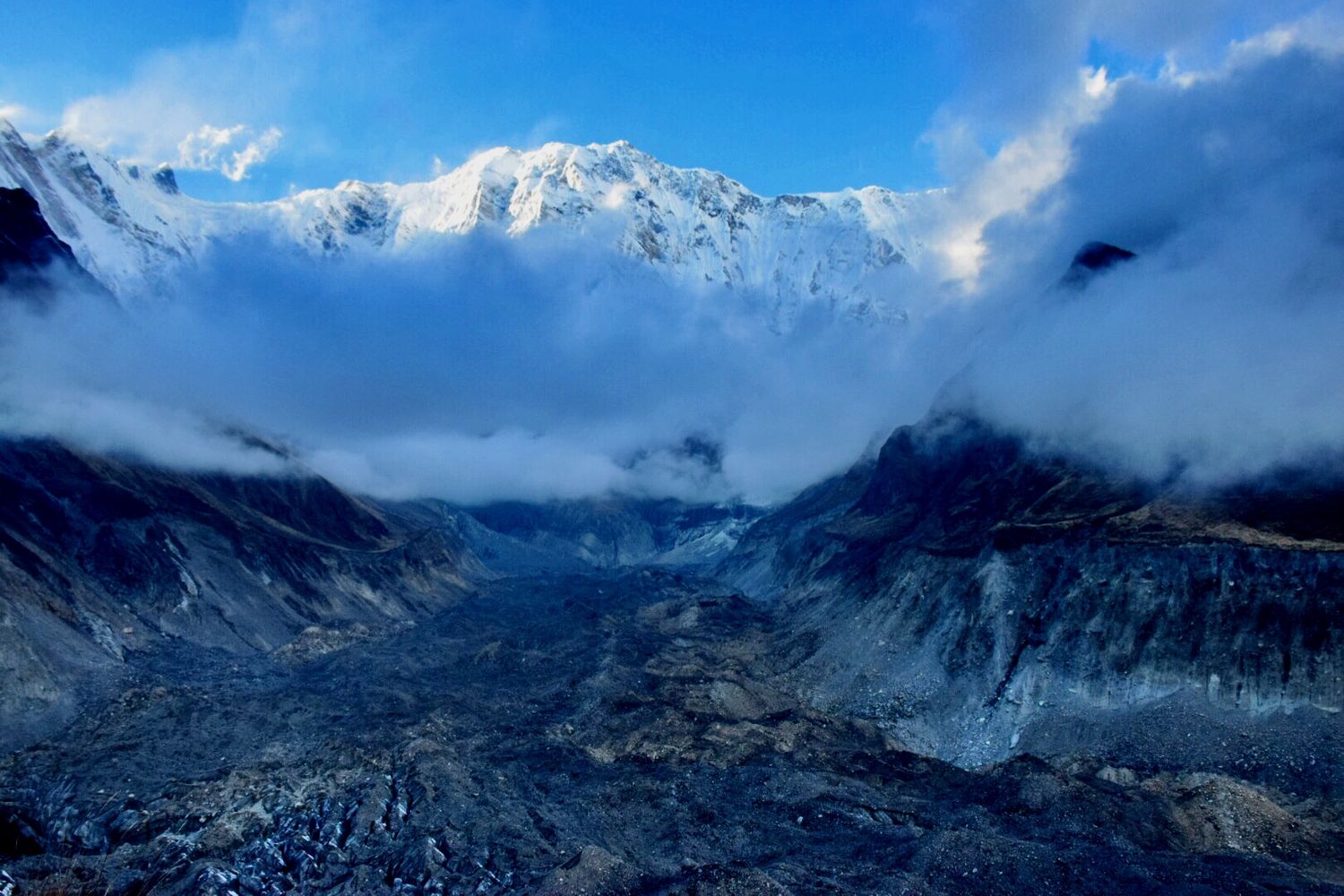
Standing tall in the heart of the Annapurna massif, located in northern Nepal, Annapurna I is the tenth highest summit in the world and one of the most challenging to climb.
On 3 June 1950, the peak became the first 8000er to ever be climbed when a French expedition led by Maurice Herzog and Louis Lachenal arrived at the summit via the north face.
How to get there
Any trip to Annapurna will begin with a flight into Tribhuvan International Airport (KTM), in Kathmandu. Most guides will opt to meet you here and arrange for transportation to Pokhara.
From Nepal’s second city, climbers will spend one week trekking to the base camp before acclimatising and beginning the ascent.
Challenges and difficulty
Annapurna is widely considered to be one of the most difficult and the most deadly 8000er to climb. The risk of avalanche is ever-present and has led to a high number of fatalities over the years. Technical rock, snow and ice climbing skills are required to reach the top.
Routes to the summit
There are two main routes that lead up to the top of Annapurna I: the north face route and south face route. The north face route is a bit less technically difficult to climb, but far more prone to avalanches. The south face route is more stable, but requires a higher level of technical ability.
Quick facts:
- Elevation: 8,091 m (26,545 ft)
- Location: Nepal
- Duration: 4 to 6 weeks
- Climbing season: April to May, September to October
11. Gasherbrum I

Also known as Hidden Peak, Gasherbrum I sits at the heart of the extremely remote Karakoram Mountains. It is the second highest peak in the range and eleventh tallest on Earth.
After two decades of failed attempts, Gasherbrum I was first successfully climbed on 5 July 1958 by an American expedition led by Nicholas Clinch via the Roch ridge.
How to get there
The vast majority of trips to Gasherbrum I begin with a flight into Islamabad International Airport (ISB). From here, most guides will meet with participants and transfer to Skardu. From Skardu, it takes about a week of driving and trekking to get to base camp.
Challenges and difficulty
Gasherbrum I is widely considered to be one of the tougher 8000ers to climb. The route to the top is long and requires a technically-challenging mix of snow and ice climbing. The approach is quite difficult as well, with plenty of scrambling and glacier travel involved.
Along with the physical and technical difficulties involved with climbing Gasherbrum I, the weather presents its own challenges. Due to the location of the peak in the Karakoram Range, weather conditions can change quickly on Gasherbrum I, adding additional uncertainty to any ascent.
Routes to the summit
While none of the routes to the summit of Gasherbrum I are taken frequently enough for there to be a ‘normal’ route, the two main routes to the top are the northwest ridge and the south ridge.
Both require technical snow climbing until the Japanese couloir is reached at the top of the northwest face. From here, only a short ascent is required to reach the summit.
Quick facts:
- Elevation: 8,080 metres (26,510 feet)
- Location: Pakistan, Tibet (China)
- Duration: 4 to 6 weeks
- Climbing season: June to September
12. Broad Peak

Sandwiched in between K2 and Gasherbrum I, on the western end of the Baltoro Glacier, Broad Peak is the twelfth tallest mountain in the world. With a summit that stretches over 1.5 kilometres (0.93 miles) in length, the mountain is quite aptly named.
One hundred years after it was first seen by Europeans, Broad Peak was climbed for the first time on 9 June 1957, when an Austrian expedition led by Marcus Schmuck arrived at the summit via the southwest route.
How to get there
The vast majority of trips to Broad Peak begin with a flight into Islamabad International Airport (ISB). From here, most guides will meet with participants and transfer to Skardu. From Skardu, it takes about a week of driving and trekking to get to base camp.
Challenges and difficulty
Due to the presence of fixed ropes and lower level of technical difficulty required to reach the summit, Broad Peak is considered to be one of the easier 8000ers to climb. A mix of modest snow and ice climbing skills are needed to reach the top.
However, due to its remote location and geography, the area is difficult to reach and requires participants to haul all of their own gear over difficult terrain. The peak is also quite exposed to storms that can form and move quickly in the area.
Routes to the summit
Overall, there are four main routes used to reach the summit, with the west ridge route being the most commonly taken one and often being referred to as the standard route. Most of the climbing on any route is pretty straightforward, if not long, with only a few steep and slightly more technical sections just prior to the summit.
Away from this route, the other main ones are the Carsolio Route, from the West Ridge to the South Face; the Long Summit Ridge Traverse; and the South West Face.
Quick facts:
- Elevation: 8,051 metres (26,414 feet)
- Location: Pakistan, Tibet (China)
- Duration: 4 to 6 weeks
- Climbing season: June to September
13. Gasherbrum II
Situated at the head of the Baltoro Glacier, straddling the Pakistani-Tibetan (Chinese) border, Gasherbrum II is the thirteenth highest peak in the world and one of the most prominent of the Gasherbrum group.
Gasherbrum II was first climbed on 7 July 1956, more than two decades after the first attempt, by an Austrian expedition led by Fritz Moravec, Josef Larch and Hans Willenpart. The party of Austrians made the ascent via the southwest ridge route.
How to get there
The vast majority of trips to Gasherbrum II begin with a flight into Islamabad International Airport (ISB). From here, most guides will meet with participants and transfer to Skardu. From Skardu, it takes about a week of driving and trekking to get to base camp.
Challenges and difficulty
Along with nearby Broad Peak, Gasherbrum II is considered to be one of the easiest 8000ers to climb and requires intermediate ice and snow climbing abilities to reach the summit.
However, the approach to the peak is quite challenging, requiring both glacier travel and scrambling. As is Broad Peak, Gasherbrum II is also quite exposed to storms, which can form quickly on the mountain.
Routes to the summit
There are a few different routes that lead up to the summit of Gasherbrum II, but the southwest ridge route remains the most commonly taken. Due to the route’s relative popularity among climbers, there are usually ladders and fixed ropes already attached along the way. This has contributed to making Gasherbrum II the easiest 8000er to climb in the Karakoram Range.
Away from the southwest ridge, another route that has been taken is the west face. This route involves more technical climbing and is generally taken by professional mountaineers.
Quick facts:
- Elevation: 8,034 m (26,358 ft)
- Location: Pakistan, Tibet (China)
- Duration: 4 to 6 weeks
- Climbing season: June to September
14. Shishapangma

Tucked onto the northern slopes of the Himalayas and towering above the Tibetan plateau, Shishapangma is the fourteenth highest mountain in the world.
Along with being the lowest of the 8000ers, Shishapangma was also the last one to be climbed. A prohibition on travel to Tibet by the Chinese government until the 1970s meant that the peak was not successfully summited for the first time until 2 May 1964, when a Chinese expedition led by Xǔ Jìng reached the top via the northern route.
How to get there
Most trips to Shishapangma begin with a flight into Tribhuvan International Airport (KTM), in Nepal. Most guides will opt to meet you here and arrange for transport to base camp, which takes about four days of driving and acclimatising. It is also possible to fly into Lhasa Gonggar Airport (LXA) and make the two day drive to the base camp.
Challenges and difficulty
Overall, Shishapangma is considered to be one of the easier 8000ers to climb and only requires intermediate-level snow and ice climbing to reach the top via the easiest route, which heads up the mountain via the northwest face and north ridge.
In spite of the relative ease of climbing, Shishapangma boasts several other challenges. During the beginning of the climbing season, avalanches are one of these as the monsoon season occasionally loosens up the snow packs.
Routes to the summit
Away from the north ridge route, there are about nine others that head up to the top of the peak. For more advanced climbers, there are at least six routes that lead up the mountain’s southern face, which boasts a 1,800-metre (6,000-foot) vertical ice climbing ascent and requires advanced technical ice climbing abilities. It is also possible to climb the peak from both the west drudge and east face.
Quick facts:
- Elevation: 8,027 m (26,335 ft)
- Location: Tibet (China)
- Duration: 4 to 6 weeks
- Climbing season: April to May, October to November
Start planning your next (or first) ascent of an 8000er!
While none of the aforementioned 8000ers are easy to climb, many are accessible to intermediate-level mountaineers with experience at high elevation.
Planning is key to a successful trip, so be sure to research which 8000er to climb, when to book the trip and what preparation is needed.
Otherwise, what are you waiting for? Begin comparing trips and planning your next mountaineering expedition to one of Earth’s 8000ers right here on ExpedReview!